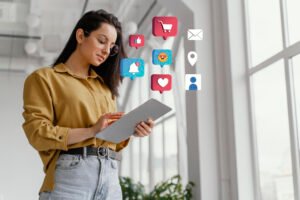Table of Contents
📝 Meta Description
“Discover how social commerce is revolutionizing shopping with in-app checkouts, live-stream selling & AI-driven personalization. Learn best strategies for seamless buying.”
Introduction
Social shopping isn’t just a trend—it’s becoming the primary way people discover, evaluate, and buy products online. By embedding commerce directly into social feeds, brands eliminate friction between inspiration and purchase. Welcome to the era of seamless buying, where discovery and checkout coexist naturally in platforms like Instagram, TikTok, Facebook, Pinterest, and more.
1. What Is Social Commerce?
Social commerce refers to a full shopper journey—from discovery to checkout—completed entirely within a social media platform reddit.com+4bigcommerce.com+4taranker.com+4brandmender.com+4moritzschroder.com+4creatorlabz.com+4. This means users can browse products, read reviews, and purchase—all without leaving the app. This in-app checkout experience boosts conversion by reducing drop-off during external redirects moritzschroder.com+2shipbuddies.com+2creatorlabz.com+2.

2. The Mechanics of Seamless Buying
2.1 In-App Checkouts & Buy Buttons
Platforms offer native tools (e.g., Instagram Shopping, Facebook Shops, TikTok Shop) enabling quick, one-tap purchases elpais.com. This keeps users engaged on the platform and bypasses slow, external redirects elpais.com+10bigcommerce.com+10srideepsendigitalmarketing.com+10.
2.2 Shoppable Content
From tagged posts & Reels to Story swipe-ups, countless content formats can be made instantly buyable. Shopify data shows shoppable posts reduce cart abandonment by up to 20% shipbuddies.com+4brandmender.com+4creatorlabz.com+4.
2.3 Livestream Shopping
Live commerce merges entertainment, education, and impulse purchase. Hosts showcase products live, answer Q&A, and using a clickable overlay—complete purchases in real time creatorlabz.com+3srideepsendigitalmarketing.com+3moritzschroder.com+3. Live shopping events accounted for 57.8% of Facebook-driven live purchases in 2022, with the global market poised to hit $256 billion by 2032 hostinger.in+1taranker.com+1.
3. Key Drivers Fueling Seamless Buying
3.1 AI-Powered Personalization
AI analyzes user behavior—likes, saves, past purchases—to tailor product recommendations. By 2025, AI is expected to influence nearly 80% of e-commerce sales sprinklr.com+3hostinger.in+3srideepsendigitalmarketing.com+3. Chatbots and product engines offer efficient, personalized assistance within social apps srideepsendigitalmarketing.com+1shipbuddies.com+1.
3.2 Augmented Reality (AR)
AR filters empower “try-before-you-buy” experiences—virtual makeup trials or furniture previews in your space. These immersive experiences can increase confidence and cut return rates by up to 40% aiecommercenews.com.
3.3 Influencer & UGC Momentum
Micro- and nano-influencers (~10K–100K followers) deliver up to 82% more consumer resonance moritzschroder.com. User-generated content (UGC)—like reviews, photos, and unboxing videos—boosts purchase trust, with 79–92% of consumers depending on peer feedback creatorlabz.com.
3.4 Community & Conversation
Brands leverage WhatsApp/Facebook groups, social audio rooms, and live Q&A sessions to cultivate trust and belonging—traits that translate into brand loyalty and sales brandmender.com+10lomitpatel.com+10creatorlabz.com+10.
3.5 Voice & Visual Search
Looking ahead: voice commands (“Buy this lipstick on Instagram”) and image-based shopping will lower barriers even further time.com+2sprinklr.com+2nypost.com+2.
4. Why Seamless Buying Works
-
Reduces friction: Every removed click boosts conversion—a built-in checkout smooths the path srideepsendigitalmarketing.com+11bigcommerce.com+11brandmender.com+11.
-
Builds trust: Live demos, AR previews, and UGC act as social proof and increase buyer confidence lomitpatel.com+7aiecommercenews.com+7creatorlabz.com+7.
-
Creates urgency: Live commerce fosters FOMO, igniting immediate purchases sprinklr.com+6moritzschroder.com+6srideepsendigitalmarketing.com+6.
-
Maximizes mobile usage: With 80+% of Gen Z shopping on smartphones, app-native buying is vital taranker.com+1lomitpatel.com+1.
-
Enables hyper-targeting: AI-driven content reaches the right person, with the right product, at the exact time shipbuddies.com+1moritzschroder.com+1.
5. Challenges to Navigate
-
Privacy concerns: Fine-tuned targeting must be counterbalanced with transparent data usage and robust protections .
-
Platform dependency: Brands rely on shifting social algorithms and policies. Diversifying platforms is wise.
-
Trust & authenticity: Avoid over-curated content. Transparency through UGC and genuine influencer partnerships is key.
-
Tech barriers: Not all users have AR-capable devices; inclusion must be prioritized.https://www.infomaster.xyz/social-commerce-seamless-buying
6. Strategic Best Practices
| Strategy | Why It Works | Tips |
|---|---|---|
| Activate In-App Stores | Minimize friction, quick sales | Set up Instagram, TikTok shops with synced inventory |
| Host Live Commerce Events | Drives urgency & engagement | Use countdowns, timed discounts, influencer partnerships |
| Use AR Filters | Reduces returns, builds confidence | Start with makeup/furniture AR try-ons |
| Partner Micro-Influencers | High engagement, niche reach | Use affiliate links, limited-time drops |
| Integrate UGC | Builds social proof | Encourage tagged posts, highlight reviews |
| Leverage AI chatbots | Personalized assistance, 24/7 | Use bots to recommend and close sales |
| Cultivate Communities | Builds loyalty | Launch private groups, live Q&A sessions |
| Explore Voice/Search | For future readiness | Set up voice-enabled features, image search tags |


